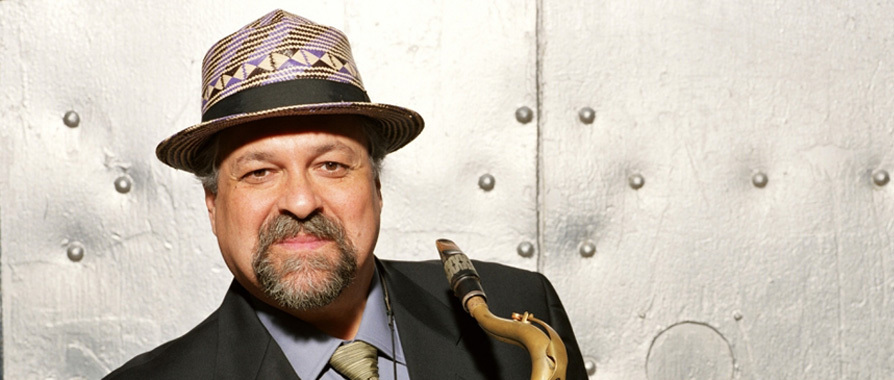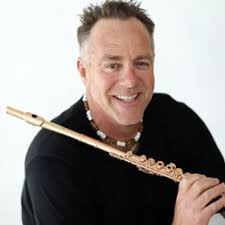Saxophone Legend Joe Lovano at TSRI

Tenor Saxophonist Joe Lovano (used by permission, La Jolla Athenaeum)
The Athenaeum Jazz series celebrates its 20th anniversary this year. Having Joe Lovano, a veteran of that opening season, return on Friday (April 7) to the Scripps Research Institute was a great call. Lovano, an unassailable tenor saxophone titan, reasserted his standing as one of the instrument’s reigning heavyweights.
For his current tour, Lovano schlepped along his working New York trio. Their uneven musicianship however, showed them to be incapable of keeping up with the demanding pace set by the intrepid leader.
From the opening medley of “Full Sun,” “Full Moon,” and “And On This Day,” Lovano demonstrated his authority through his highly personalized and abstracted style. Mastery was evident in his huge tenor sound, full three-plus octave range and deep-pocket rhythmic groove. Joy and youthful insouciance radiated from the entire band, although rhythmic issues plagued them throughout the night.
Despite Lovano’s stature as one of the major tenor saxophone personalities of our time, his sound is a throwback to a bygone era. Its full-body timbre can be partly attributed to his gear choice of an unusual grenadilla wood mouthpiece and hand-pounded Borgani saxophone. One of his most distinctive and remarkable traits is a Sonny Rollins-like control of the low register, capable of honking or whispering at tempo or in a ballad.
Another of his most laudable skills is an absolutely rock solid sense of time–in contradistinction to that of his sidemen. No matter how quickly or slowly Lovano plays, the time never budges. In fact, he consistently plays on the back side of the beat in a style pioneered in the 1930s by Count Basie and his Kansas City colleagues.
The rest of his band, unfortunately, didn’t seem to get the memo. Perhaps they were fatigued from being on the road. Or perhaps TSRI’s acoustics threw them off. Or perhaps the monitors and stage sound were not optimal. Whatever the problem, throughout the entire concert and regardless of tempo, the rhythm section never locked in as a unit. One perplexing aspect of this state of affairs is that owing to Lovano’s international fame and standing, he can hire nearly anyone he wants, so his choice of these three performers is curious. Pianist Leo Genovese, bassist Peter Slavov and drummer Lamy Istrefi may all be wonderful virtuosos in their own right, but their perversion of the time feel did a disservice to the music and their boss.
Lovano’s opening original, the forlorn ballad “Full Moon,” allowed us a privileged look into his personal artistic concept. Traditionally (and simplistically speaking) in tenor “saxology,” there have been two major esthetic streams: one emanates from Lester Young and the other from Coleman Hawkins. Young’s improvisational approach was mostly characterized by highly lyrical horizontal lines that generally eschewed arpeggiation and chord superimposition. Hawkins, on the other hand, pioneered a tenor style that while melodic, was more focused on the “stacking” of simple chords, resulting in complex harmonic constructs from a primarily monodic instrument. Yet, owing to their deep roots as members of famous and successful dance bands, both iconic virtuosos’ grooves were profound, a trait that Lovano has inherited. He seems to hail more from the Lester Young school with its linear approach nonetheless informed by advanced harmonic ideas, as opposed to the more vertical approach of Hawkins and his followers.
Lovano’s style displays a nearly obsessively narrative sense, a feeling of “journey” that rests upon his heady admixture of chromatic harmony, perfect intonation and wondrous time feel. In it, there is a constant sense of fracturing and reassembling along an ineffable voyage reminiscent of the cubism of Picasso and Braque.
“And On This Day” allowed Lovano an opportunity to “preach” as in Coltrane’s “A Love Supreme.” Istrefi’s drum solo likewise channeled drummer Elvin Jones’ brawny, masculine and complex style. The piece utilized a freely narrative opening section, apparently without fixed measures which led to a hard swinging, contrasting modal “B” section based upon two chords. Lovano’s blues inflected solo belied him not as a giant technician but one, instead, who has developed the requisite technique to cleanly articulate his idiosyncratic harmonic ideas. In this, Lovano’s approach to technique is akin to Coltrane and Michael Brecker: digital pyrotechnics are never tossed off self-aggrandizingly but instead, utilized only in the service of executing unique musical ideas.
In contrast to Lovano’s pristine playing, pianist Genovese followed with a fiery solo that was marred by split notes, questionable time and ideas that were left uncleanly etched. Throughout, drummer Istrefi was the engine that ran this band with his high energy work.
My erudite old friend Dave Weiss, the New York woodwind legend, scholar, original and current soloist in “Lion King” on Broadway, informed me that Lovano’s instrumental choice for his original “Razzle Dazzle” was a tárogató. The instrument is a rather bizarre and rare Eastern European great-grandparent of the soprano saxophone with roots dating back to the 15th century. Lovano makes frequent use of a modern version of the instrument that was redesigned with a Boehm system in the 19th century. The mournful sound of the instrument was well suited to Lovano’s implementation although the horn’s intonation in slow passages is painful. The entire band read music on the tune, indicating that it was a newer addition to their repertoire since the rest of the program was performed almost entirely by heart. Lovano’s sylvan playing imposed large meta-rhythmic commentary over a complex, double-time brush pattern that suggested the early Keith Jarrett Quartet with saxophonist Dewey Redmond and drummer Paul Motian.

Channeling the voice of Coltrane once again with his performance of the standard ballad “It’s Easy to Remember,” the audience was presented with an advanced post-post-bop treatment of the tune. It’s very difficult not to hear Coltrane on any of the tunes featured on his “Ballads” album, yet Lovano deftly transcended the model of that vintage 1960s Impulse recording which has been seared into our brains. Not surprisingly, Lovano pulled this feat off by using his patented smooth, scalar fracturing of the harmony and outlining his own wonderful substitutions. Again, recalling cubist masters from other media, he used very deliberate chordal superimpositions, thus articulating his own clean and unique interpretation. Also, not surprisingly, his band rushed (aaaaaargh! C’mon, guys!).
After a Bird-like tune based on “Taking A Chance On Love” changes, the band took an intermission. Returning for a second set, these journeymen went on to conclude a nearly two and one half hour program before relenting to an exhausted audience.
I eschew the moniker “artist” in favor terms that are more highly charged for me after a forty plus year performing career. “Professional.” “Musician.” “Integrity.” These are the labels that every conscientious performer aspires to and Lovano lays legitimate claim to them all. Kudos and sincere gratitude to you for a well-played career, Mr. Lovano, and may you go on to embody these transcendent attributes for many, many more years to come.

Yochanan Sebastian Winston, Ph.D. has performed throughout the United States, Europe and Latin America. His repertoire spans classical, jazz, klezmer, new age, contemporary, rock & roll and pop and is very active as a composer. Dr. Winston holds a Ph.D. from the UCSD, a Diplôme from the Conservatoire National de Region de Boulogne-Billancourt (France), and a Master’s and Bachelor’s of Music from the Manhattan School of Music in New York City.

Thanks for a nice review of a fun evening, Just fyi, last tune of the first set was based on Bye Bye Blackbird.
Could be. I don’t recall hearing it before. Do you happen to know what the tune is called? Thanks for your kind words although I’m not really sure what you mean by “nice.”
Well thought out review. U make the reader interested. Like a salesman. I look forward to ur reviews. Great job both u and Joe lovano!
Thanks!
I was the sound engineer at this concert. A couple of comments: The band had an extensive sound check. They were very happy and comfortable with what they were hearing on stage at that point. Also, other than the musical issues that you addressed, the drummer also played MUCH to loudly for the room, in my humble opinion.